
|
Entrances of All-Time 1920s-1935 |
| Movie Title/Year and Film Character with Scene Description | ||||||||||||
 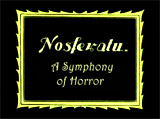 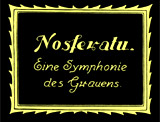
|
Nosferatu, Eine Symphonie des Grauens (Nosferatu, a Symphony of Horror/Terror) (1922, Germ.)
Murnau's expressionistic film was an unauthorized film adaptation of Stoker's Dracula with Max Schreck in the title role as the screen's first vampire - a mysterious aristocrat living in distant Bremen named Count Graf Orlok.
Orlok actually first appeared as the driver of a black-swatched coach, sent to pick up visiting Bremen real estate agent Johannes Hutter (Gustav von Wangenheim), after he had been deposited as close as possible by the fearful villagers of the Carpathian Mountains region. Once they arrived up the hill at the Transylvanian castle, the driver gestured and pointed for Hutter to enter. As he walked into the concrete castle through various Gothic arches, the tall, gaunt, big-nosed Count Orlok appeared and was there to greet him. He was annoyed: "You have kept me waiting -- too long -- it's almost midnight. The servants are asleep!" The two entered the darkness of the castle - at the end of Act I. The most dramatic and remembered entrance of the vampire came later, at the start of the next night, while Hutter was either sleeping or rendered unconscious. The emaciated, balding undead vampire's image was unforgettable with a devil-rat face, pointy ears, elongated fingers, sunken cheeks, and two long toothy fangs. He was seen first at a distance, but then quickly approached (through dissolves) until he was completely in the curved, pointed doorway with a Gothic arch, revealing his ugly, scary figure. (At the same time, Hutter's wife in Wisborg sensed that something was threatening her husband, and she called out his name.)
The shadow of Orlok, with his outstretched pointy fingers, soon began to envelop a sleeping Hutter, but then unexpectedly, departed through the same doorway, which closed behind him. |
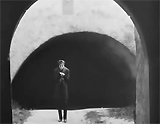     Orlok's Departure |
||||||||||
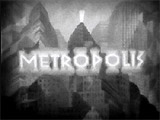
|
The first view of Maria (Brigitte Helm) was ethereal. It was in the scene of Maria showing children of workers to the upper level of Metropolis, in an attempt to have them see the life of the rich. She told them: "Look. These are your brothers." She inadvertently attracted wealthy Freder's (Gustav Frohlich) attention. Maria's words and beauty deeply touched him, and after Maria was escorted out of the gardens, Freder clutched his breast with adoration, and for the first time saw the frivolous wastefulness of life in the upper city and the pleasure garden. |

|
||||||||||

|
The first glimpse of Transylvanian Count Dracula (Bela Lugosi), a 500 year old vampire, was shocking. He was standing upright next to his coffin, wrapped tightly in an all-enveloping black cape. His ashen face, with a piercing, unmoving, cold fixed gaze, was illuminated with an unholy glow from the twilight and his black hair was slickly combed straight back. Rats scurried about and wolves howled. Dracula was then seen sitting atop a carriage dispatched from the castle. He was a tall, silent figure, wrapped in a black cape and staring hypnotically straight ahead. In the dark cavernous entry-room of Dracula's castle, the dwarfed figure of passenger Renfield (Dwight Frye) stood at the bottom of the wide and long stone staircase of the castle. An ominous silence hung heavily in the air. Dracula - elegantly dressed in a black tuxedo, slowly descended the massive staircase while holding a single candle. Rats and armadillos scurried across the dirt-covered stone floor. A giant spider web hung from the ceiling above the staircase. When Renfield turned, he was startled to find Dracula walking through the large spider web without disturbing it. Although mildly threatening, Dracula glided toward him and memorably introduced himself in an immaculately delivered line (uttered with a Hungarian accent):
|
     
|
||||||||||
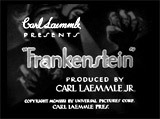
|
The giant Monster (Boris Karloff), kept in total darkness for a few days, had developed enough strength to shuffle forward (like a teetering toddler) and enter into the mad scientist's laboratory from the dark corridor. The first appearance and unveiling of the Monster - bringing him into the light of enlightenment - was truly memorable. The door slowly swung open, revealing a dark, lumpish silhouette in the doorway in a full figure shot. The bulky figure lurched clumsily into the room with halting steps, gradually revealing a bulky head and broad back - the Monster awkwardly moved into the room by backing in! The hulking Monster then slowly turned around, and then provided a shadowy profile in the first chilling close-up look of his blankly expressionless, tabula rasa face - a jagged surgical scar around the jaw appeared. There was also a prominent spike or bolt that gleamed into view on the side of the figure's neck. A series of camera jump cuts provided increasingly tighter close-ups of the hideous visage of the cadaverous creature. The Frankenstein Monster was a startling, grotesque, and gruesome figure, about seven feet tall with broad shoulders. The creation was more Monster than man. The monstrous face was placid, gaunt and elongated. The creature had a square-shaped head with boxy forehead, hooded eyelids over deep-set sunken eyes, neck-spikes or bolts to serve as electrical connectors on his neck, jagged surgical scars, and a matted wig. The Monster wore a dark suit and thick, heavy boots, causing him to walk with an awkward, stiff-legged, crude gait. His long arms seemed enormous because the coat sleeves were shortened. |
 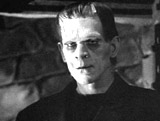 
|
||||||||||
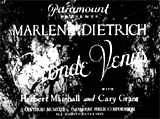
|
Blonde Venus (1932)
Director Josef von Sternberg's melodrama was best known for its key scene in which Marlene Dietrich made a startling appearance. The memorable entrance sequence occurred in a jazzy German nightclub (to the beat of an African drum) in which singer Helen Faraday (Marlene Dietrich) opened the cabaret show by first appearing in a full-body gorilla suit as a chained ape, led into the audience by chorus girls (carrying shields and spears) who were adorned with war paint on their faces and wearing large black afro wigs. She revealed herself via a striptease. At first she removed one glove to show off her human hand with bracelets, and then the second glove, followed by the removal of the gorilla head-piece. She placed a blonde Afro wig on her head before singing "Hot Voodoo" in a throaty voice - as she stood with hands on her hips before the chorus line of archetypal 'native' dancers. The lyrics (in part):
|
    
|
||||||||||
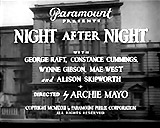
|
This early 30s film was known for its debut of the inimitable, wise-cracking sex symbol Mae West in her first talking film (in a supporting role). In her part as uncouth Maudie Triplett, West made a memorable first entrance on the screen, with what may be considered the single greatest opening bit in any film actress's career. Outside of a nightclub, she was surrounded by men, waiting to be let in with her. One of them asserted: "We're going in with you, Maudie." She joked: "You know my father's very strict and he won't let me see boys after nine o'clock...Why don't you guys be good and go home to your wives?" She was standing next to the door's peephole, when the doorman Patsy (Dink Templeton) asked: "Who is it?" She replied impatiently: "The fairy princess, ya mug!" When she was allowed in, she warned: "Don't let those guys in, they'll wreck the joint." She then swaggered into the nightclub, well-dressed and covered with jewels, where the wide-eyed cloakroom hat-check girl, overwhelmed by her, admired her diamonds:
|
   
|
||||||||||
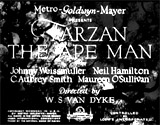
|
In the first of many Tarzan films, the introduction of ape man Tarzan (Johnny Weismuller) with accompanied by his famous trademark jungle call:
He swung on vines from tree to tree, followed by the first good look at the jungle man peering down at the group of white explorers from a tree perch. |

|
||||||||||
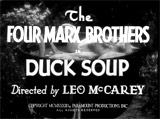
|
The opening scene was the classic inaugural ceremony and lawn party for the conferring of the Presidency of the tin-pot republic of Freedonia to a newly-appointed leader, Rufus T. Firefly (Groucho Marx), characterized by a supportive Mrs. Teasdale (Margaret Dumont) as "a progressive, fearless fighter." The assembled audience sang the national anthem "Hail, Hail Freedonia," but Firefly wasn't anywhere in sight. After a long pause and a trumpeters' fanfare, the anthem was sung a second time and all the guests looked toward the entrance, but Firefly still failed to enter. Suddenly, in an upstairs bedroom, the ringing of a loud alarm clock was heard, and Firefly abruptly sat up in bed with a nightshirt, nightcap, and cigar - he quickly removed his nightshirt to reveal a suit, and slid down an unlikely fireman's pole into the spacious ballroom hall to take his place in the line-up at the end of the ceremonial line with his own honor guard . He asked one of the guards: "You expecting somebody?" and then joined them to wait for his own arrival while holding out his cigar (rather than a sword). When noticed, he insulted everyone in sight - especially his benefactress, and sang the song "Just Wait 'Til I Get Through With It" about how he intended to abuse his power. |
   
|
||||||||||

|
Statuesque blonde Mae West's second starring feature film comedy opened with a one-ring circus and sideshow carnival barker (Russell Hopton) tempting a crowded audience at Big Bill Barton's Wonder Show. His first words were to lure in middle-aged male patrons to see the various attractions, including Joe the Turtle Boy:
Then, he introduced carnival queen and dazzling international small-time, vamp circus star performer Tira (Mae West) in a sequined, tight-fitting gown:
Tira made a sauntering entrance on the catwalk amidst the barker's words, and purred to spectators to follow her behind the curtain:
|
   
|
||||||||||
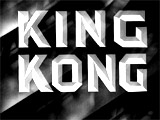
|
The natives on Skull Island had prepared kidnapped blonde white girl Ann Darrow (Fay Wray, the 'scream queen') as their new sacrificial bride. The witch doctors opened the tall gate (by drawing back the huge, phallic-like bolt) in an enormous wall and dragged her to the top of a high stone altar at the edge of the jungle. Her wrists were spread and bound to two great pillars or altar stakes. Then, the natives fled back behind the safety of the enormous gate-wall, struck a gong to summon Kong, and waited atop the wall to watch. Left invitingly open to attack, Ann sobbed helplessly on the altar. The brutish Kong made an extremely memorable first appearance. The mighty ape was first heard as he came angrily thrashing and stomping through the jungle, bending nearby trees. Horrible roars, growls, and sounds were heard from an indistinct shape. When he came into view, he was tremendous - a thirty-foot tall giant ape, much bigger than a gorilla.
As she saw the demonic, strong Beast-lover approaching the altar, she struggled to free herself from chains holding her to posts. She let out shrill screams in absolute terror, just like in the practice session. Her eyes signified complete fear and helplessness. With raw sexual impulses that had been incited and aroused by a rolling-eye view of the white girl, Kong flared his teeth and snarled, beat his chest and let go mighty roars. As he came closer to leer at her, he released her from the stakes, and she slumped into a faint. Kong picked her up with his giant paw, as the natives cheered enthusiastically at Kong's acceptance of the valued sacrifice (worth six black native girls). She succumbed to the naked Beast's dark libido. Rather than devouring her, the hairy colossus carried her off into the jungle as she continued to scream. |
   
|
||||||||||
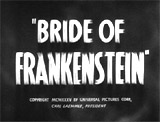
|
This Universal monster film followed the ending of the original film Frankenstein (1931), when the mill was burned to the ground as peasants from the village cheered the end of the Monster. To restore order, the village's burgomaster (E. E. Clive) declared the Monster dead and encouragingly sent the mob home. Hans (Reginald Barlow) and his wife (Mary Gordon), the peasant parents of the little girl the monster had accidentally drowned, lingered at the site. Unsatisfied and vengeful, Hans was determined to view the Monster's remains: "I want to see with my own eyes...If I can see his blackened bones, I can sleep at night." His wife pleaded with him that nothing could bring back their murdered daughter: "Oh Hans, he must be dead. And dead or alive, nothing can bring our little Maria back to us." When Hans walked over the unstable beams from the wreckage of the fire, he fell through the collapsed floor and splashed into an underground millpond/cistern below. With emphasis from the musical score for a dramatic entrance, the creature's hand and arm first appeared from behind a wooden beam, and then the Monster stepped fully into view from the shadows. In a close-up, there were grotesque electrodes or bolts at the neck and he had a flat, square head (and a face scarred by the fire). Hans was held under the waist-deep water and drowned by the Monster. A sleepy-looking owl witnessed the murder. |
 
|
||||||||||

|
The presentation of the birth of the Monster's Bride (Elsa Lanchester) was stunningly grotesque. When mad scientist Pretorius (Ernest Thesiger) removed the bandages from her eyes, two uncomprehending globes stared back, as the soundtrack emphasized the revelation. Henry Frankenstein (Colin Clive) exclaimed typically: "She's alive! Alive!" The two scientists tilted the table to an upright vertical position. The Bride stiffly raised her arms and then collapsed. After the bandage-covered Bride had her wrappings removed, indicated by a dissolve, she was unveiled and viewed in full, chilling splendor. The repellently-beautiful female wore a flowing white shroud (laboratory smock) and a wild, frizzled fright wig. Streaked with white from lightning charges, her backlit bouffant hairdo stood straight out behind her, making her look dramatically like Queen Nefertiti. Stitches were visible beneath her jaw. Her angular movements were bird-like - her sharp-boned and angular head jerked and darted from one position to another. Appropriately, her white covering could be mistaken for a bridal gown - Pretorius announced: "The Bride of Frankenstein!" |
   
|
||||||||||
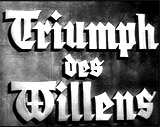
|
Triumph of the Will (1935, Germ.) (aka Triumph Des Willens)
In the opening of Leni Riefenstahl's influential yet infamous propagandistic documentary film that glorified Hitler and his regime over a four day period in Nuremberg, Germany in 1934, the entrance of Fuhrer Adolf Hitler was remarkable. With ethereal and visual imagery, Hitler's plane made a god-like descent from the clouds as he arrived over the city of Nuremberg (with the sight of the plane's dark shadow moving over buildings and the landscape, and the long lines of marching men below appearing ant-like). And then after his plane landed on a field, he emerged from the airplane as a Messiah-like, savior-figure with a demure smile. Soon, his triumphant motorcade reviewed the cheering, adoring and worshipping throngs of celebrity-followers, many of whom (almost in mass hysteria) raised their arms with the 'Heil Fuhrer' Hitler salute to honor their idolized, omnipotent leader. |
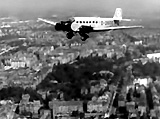  
|
||||||||||
(chronological, by film title) Introduction | 1920s-1935 | 1936-1939 | 1940-1945 | 1946-1949 | 1950-1955 | 1956-1959 | 1960-1965 | 1966-1969 1970-1975 | 1976-1979 | 1980-1985 | 1986-1989 | 1990-1995 | 1996-1999 | 2000-2005 | 2006-Present |